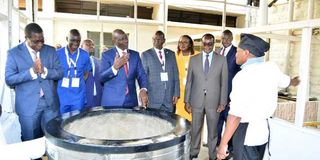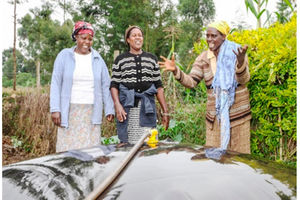LPG progress in schools: Can biogas take it further?

President William Ruto (third left) with (From left) Cabinet Secretary for Energy and Petroleum Opiyo Wandayi, Jamhuri High School Principal Duncan Juma, Principal Secretary for Petroleum Mohammed Liban and Cabinet Secretary for Education Julius Ogamba during the official commissioning of the Liquefied Petroleum Gas (LPG) project for Jamhuri High school and Official launch of the LPG Programmed for Public Institutions of Learning on December 16, 2024 at the School grounds in Nairobi. PHOTO|BILLY OGADA
What you need to know:
- Most Kenyans still rely on charcoal and firewood for cooking
- The government's decision to promote the use of LPG in public schools is a commendable step forward; however, it remains unaffordable for the majority of Kenyan households.
- The government should consider biogas generated power for cooking and lighting
The government has finally recognised the need to transition public schools away from using charcoal and firewood, which harm public health and undermine forest conservation efforts. However, it should also explore the potential of bio-digesters, especially since many public schools still rely on pit latrines. As this initiative progresses, prioritising affordable and clean energy solutions will be essential.
The country continues to engage in discussions on climate change mitigation, yet it has not fully addressed the impact of biomass, despite the availability of alternative local energy sources that could be utilized in institutions such as schools, hospitals, and factories.
Most Kenyans still rely on charcoal and firewood for cooking. Even in our metropolis Nairobi, charcoal bandas are a main feature in most estates. This is an environmental disaster if you consider the number of trees felled every year.
The government's decision to promote the use of LPG in public schools is a commendable step forward; however, it remains unaffordable for the majority of Kenyan households.
It should also look at the possibility of embarking on biogas use since most institutions are still using pit latrines and this is a good source of biogas. Some schools also keep dairy cows and the possibility of bio-digesters should be exploited because it can become a reality.
The possibility of using biogas in most homesteads in the rural areas where the raw material is readily available should also be explored as dairy farmers in Kenya today are experimenting with zero grazing and cow dung is the raw material for it. The national and county governments should if possible partner and make this a reality.
Innovators of the bio-digesters have grown in leaps and bounds and all that is required to encourage biogas use on a bigger scale is to facilitate and make bio-digesters affordable to many households.
Awareness creation should be facilitated on the methodology of bio-digester installation and the methods of converting it into cooking gas and lighting in the houses. It is possible and can be done easily. What the County governments in areas where daily farming is the vogue should do is educate masses on this source of clean energy that is within their reach.
What however the country should immediately address is the prohibitive cost of the bio-digesters and the accompanying gadgets that will make rural folks enjoy free energy and contribute towards greenhouse gas reduction thereby contributing locally to climate change mitigation just like it is doing with LPG in learning institutions.
For the sugar factories, the possibility of using the bagasse waste to generate energy is still very viable. I reckon, in 2014, a partnership among organisations set up a bio-centre in the Kibera slum. The equipment installed was used to divert human waste into a digester that would automatically generate biogas. This could be revived and escalated to the households. Bearing in mind the high burden of respiratory diseases, this can go a long way in dealing with the menace.
Mr Kigo is a retired environment officer. Email: [email protected]




